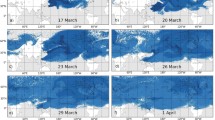Abstract
Based on the analysis of multi-year monitoring data on atmospheric air contamination in the vicinity of Lake Karachay, Reservoir V-9, a model is suggested here for carry-over of radionuclides (trace elements) in the form of water aerosols from the reservoir surface area. The concept of fractionation (accumulation) coefficients is introduced for different radionuclides present in V-9 Reservoir water aerosols as compared to the reference radionuclide 137Cs. The range of possible fractionation coefficient values is estimated for 134Cs, 90Sr, 103,106Ru, 95Zr+ 95Nb, 125Sb, 144Ce and Pu radionuclides. It is shown that, for a numerical assessment of radioactive pollution of the atmosphere with water aerosols, it is convenient to express the capacity of the source of releases as a product of three factors: (1) the activity concentration in the reservoir water, (2) the effective rate of generation of water aerosol volume from the reservoir surface area (~ 20 cm3 m−2 year−1 in relation to the reference radionuclide 137Cs), and (3) the fractionation coefficient of the radionuclide under consideration in water aerosols as compared to the reference nuclide. It is proposed here to model transfer and dispersion of water aerosols in the atmosphere using the standard Gaussian model, and it is shown that this allows estimation of atmospheric pollution in the vicinity of the reservoir with acceptable accuracy.





Similar content being viewed by others
References
Batorshin G, Mokrov Yu (2018) Experience and the results of emergency management of the 1957 accident at the Mayak Production Association. J Radiol Prot 38(1):1–12
Drozhko E, Samsonov B (eds) (2007) Reservoir 9 as liquid radioactive waste storage pond and its effect on the geological environment. Rosatom, Moscow, p 250 (in Russian)
Gusev N, Belyaev V (1991) Radioactive releases into the biosphere: reference book. Energoatomizdat, Moscow, p 256 (in Russian)
Karavayeva E (1992) Fractionation of ionic composition in the ocean surface microlayer depending on heat mass exchange with the atmosphere. Abstract of Ph.D. thesis in physical and mathematical science, Moscow (in Russian)
Korsakov Yu, Fedorov E, Romanov G, Panteleyev L (1996) Assessment of radiation environment in the territory contaminated as a result of radioactive aerosol wind carry-over in the enterprise vicinity in 1967. Radiat Saf Probl 4:50–59 (in Russian)
Kuznetsova M, Karavayeva E, Tverdislov V (1992) Dependence of ion fractionation coefficient in sea aerosols on rate of evaporation from the sea surface, series 3. Physics, astronomy. MSU Vestnik. 33(5), 85–87 (in Russian)
Lukshene B, Styro B, Shpirkauskayte N (1988) Study of radionuclide accumulation in the surface microlayer of the baltic sea. Atmos Phys 12:155 (in Russian)
Mokrov K, Mokrov Yu (2015) Analysis of atmospheric fallout of cesium-137 in the Mayak PA observation zone by the example of Novogorny Settlement. Radiat Saf Probl 2:16–27 (in Russian)
Mokrov K, Mokrov Yu (2016) Study of Parameters of the source of water aerosol generation from Karachay Lake water area. Rad Saf Probl 1:20–29 (in Russian)
Mokrov K, Mokrov Yu (2017) Study of atmospheric contamination in the vicinity of Karachay Lake as a result of water aerosol wind carry-over from its surface. Radiat Saf Probl 1:67–79 (in Russian)
Mokrov K, Mokrov Yu (2018) Assessment of integral carry-over of long-lived radionuclides with water aerosol of karachay lake based on analysis of the data on the soil contamination in its vicinity. Radiat Saf Probl 1:19–35 (in Russian)
Mokrov Yu, Mokrov K, Ishunina M, Efimov A, Romanov S (2017) Assessment of the role of various sources of atmospheric contamination with plutonium in the vicinity of the Mayak PA between 2002 and 2016. Radiat Saf Probl 2:35–46 (in Russian)
Muramatsu Y, Rühm W, Yoshida S, Tagami K, Uchida S, Wirth E (2000) Concentrations of 239Pu and 240Pu and their isotopic ratios determined by ICP-MS in soils from the chernobyl 30-km zone. Environ Sci Technol 34:2913–2917
Nelis P (1990) The transfer of radionuclides from sea to land in sea spray. Submitted for the Degree of Doctor of Philosophy, University of Edinburgh, Edinburgh
UNSCEAR (2000) Sources and effects of ionizing radiation, report to the general assembly, with scientific annexes, v. 1: Sources, New York
Vakulovsky S (eds) (2002–2016) Radiation environment in the territory of russia and neighboring countries: yearbooks. Rosgidromet, RPA “Typhoon”, Moscow (in Russian)
Author information
Authors and Affiliations
Corresponding author
Ethics declarations
Conflict of interest
The authors declare that they have no conflict of interest.
Additional information
Publisher's Note
Springer Nature remains neutral with regard to jurisdictional claims in published maps and institutional affiliations.
Rights and permissions
About this article
Cite this article
Mokrov, Y.G., Mokrov, K.Y. Modeling of atmospheric transfer of radionuclides in the form of water aerosols from the surface area of water bodies using the example of Lake Karachay, Russia. Radiat Environ Biophys 58, 393–405 (2019). https://doi.org/10.1007/s00411-019-00799-w
Received:
Accepted:
Published:
Issue Date:
DOI: https://doi.org/10.1007/s00411-019-00799-w




